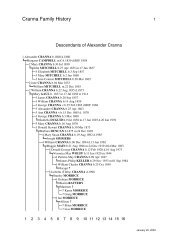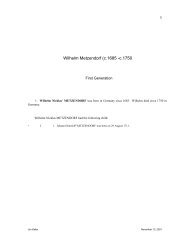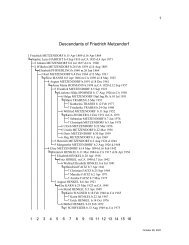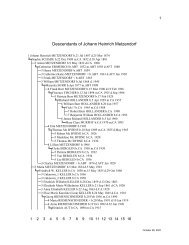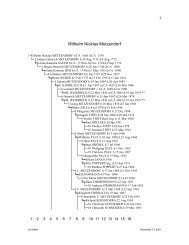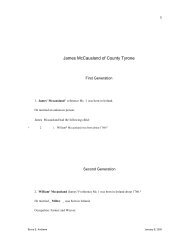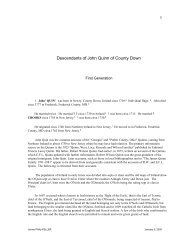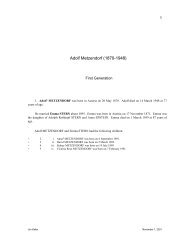The Quinn Family - Jim and Trish Keller
The Quinn Family - Jim and Trish Keller
The Quinn Family - Jim and Trish Keller
- No tags were found...
Create successful ePaper yourself
Turn your PDF publications into a flip-book with our unique Google optimized e-Paper software.
A short Account of the <strong>Quinn</strong>, West, Lacy, Pottenger, Kincade <strong>and</strong> Wilson FamiliesE.F.L. <strong>Quinn</strong>{page 5}THE QUINN FAMILYINTRODUCTION BYE.F.L. <strong>Quinn</strong>Murray in his Irish guide book says that the name <strong>Quinn</strong> was originally spelled “Cuin” <strong>and</strong> was the Irish name of atree that the English called the arbutus. <strong>The</strong>re is an old Abbey in county Clare known as Quin Abbey. No member ofany family bearing the name of Quin had any connection with the Abbey, but the name was given it according toMurray, owing to the fact that it was located in a grove of “Cuin” or arbutus trees. <strong>The</strong> family of the Earl ofDunraven who bear the name of Wyudham-Quin live in this section.This seems a plausible explanation of the origin of the name but the Irish genealogists trace all the clans to somechief or “king” in Irel<strong>and</strong> <strong>and</strong> they have traced the <strong>Quinn</strong> clan to Nial, king of Irel<strong>and</strong> in 379 <strong>and</strong> to Conn of the onehundred battles, who lived some centuries later. Cuin, the original form of the name, being the genitive of Conn.<strong>The</strong>re was an English family named “Quiney” that lived in Stratford-on-Avon in the reign of Queen Elizabeth. Oneof them was the chief magistrate of Stratford for many years <strong>and</strong> one of his sons married a daughter of Shakespeare.<strong>The</strong>re was also an English family named Quinlan.<strong>The</strong> population of Irel<strong>and</strong> in early times was divided into septs or clans <strong>and</strong> the old maps of Irel<strong>and</strong> show theO’Quin sept or clan to have lived in Ulster where the counties of Armagh, Derry <strong>and</strong> Down join. <strong>The</strong> principalclans in Ulster were the O’Neils <strong>and</strong> the O’Donnels, the O’Neils being the ruling sept or clan in Ulster.In. 1607 occurred what is known in Irish history as the “flight of the Earls,” that is the Earl of Tyrone, chief of theO’Neils, <strong>and</strong> the Earl of Tyrconnel, chief of the O’Donnels, being suspected of treason, fled to France. <strong>The</strong> Englishgovernment declared all the l<strong>and</strong> belonging not only to the O’Neils <strong>and</strong> O’Donnels, but l<strong>and</strong> belonging to thesmaller clans like the O’Quins, forfeited <strong>and</strong> in 1609 expelled all the Catholic Irish from northeastern Ulster, thel<strong>and</strong> being granted to English <strong>and</strong> Scotch settlers. A few of the Irish who conformed to the English rule <strong>and</strong> theEnglish church were permitted to remain <strong>and</strong> were given grants of l<strong>and</strong>.Among, these favored ones were two who bore the {page 6} name of <strong>Quinn</strong>. <strong>The</strong>y were each granted l<strong>and</strong> nearNewry. <strong>The</strong> laws of Irel<strong>and</strong> made it a unlawful offense for a protestant to marry a catholic <strong>and</strong> so in the course ofyears the protestant Irish families became completely anglicized from inter-marriages with their English neighbors.Our information about the family prior to the birth of John Quin, the emigrant, is very scanty. He claimed to beEnglish, but it is more than likely that he was descended from one of the Irish who conformed to the English churchin 1609, their families being absorbed into the English population through intermarriage. <strong>The</strong> war, in which one ofthe family was engaged in Engl<strong>and</strong>, was probably that between Charles I <strong>and</strong> Parliament. My father seemed to thinkthat the family had lived in Engl<strong>and</strong> for some time.John Quin Sr., died in the winter of 1776 or spring of 1777 <strong>and</strong> as he was said to have been 67 years of age at thetime of his death, he was born either in 1709 or 1710. While my father’s record merely says that John Quinemigrated from the north of Irel<strong>and</strong>, it is known that he lived on his farm in county Down near Newry. Freemasonrydates from the Gr<strong>and</strong> Lodge of London in 1717 <strong>and</strong> was first extended to Irel<strong>and</strong> in 1729. <strong>The</strong> fact that John Quinwas a Mason in 1746 would indicate that he was of some importance. Traveling was expensive in those days <strong>and</strong>the fact that he made three trips across the Atlantic would indicate the possession of some means as well as anenterprising disposition. He was said to have been a very strong man <strong>and</strong> considerably over six feet tall. My fatherhad heard a story about his getting up out of a sick bed in the last year of his life <strong>and</strong> single h<strong>and</strong>ed, driving a squadof soldiers out of his house. He was too old to engage in the war of the Revolution <strong>and</strong> while he said that he washimself bound by his oath of allegiance he offered no objection to his son Richard enlisting in the Continental army.He lived in New Jersey until about 1762 when he removed to the neighborhood of Frederick, Md., <strong>and</strong> died there inthe winter of 1776 or spring of 1777. We have no knowledge of where he lived in New Jersey or what hisoccupation was in this country, but presume it was farming as that was his occupation in Irel<strong>and</strong> <strong>and</strong> the occupationof his children <strong>and</strong> most of the descendants in this country. His second wife was said to have been about half hisage when he married her in 1754.His son, Richard Quin, born February 14, 1755, is shown by the Maryl<strong>and</strong> Archives to have enlisted at Frederick,Maryl<strong>and</strong>, on May 1, 1778, in the German regiment of the Maryl<strong>and</strong> line of the Continental army, for the period ofthe war. {page 7} This regiment was so called owing to the fact that Frederick was mainly a German village.<strong>The</strong>re is no record of any military service of any of Richard’s brothers, although Robert <strong>Quinn</strong> is supposed to haveserved in the Maryl<strong>and</strong> militia. John Quin, Sr., <strong>and</strong> Richard Quin used one “n” in their names, all the rest of thefamily used two “n’s.”About the close of the Revolution the family removed from Frederick to the neighborhood of Georgetown, Md.,probably in Virginia as I have heard my father speak of his gr<strong>and</strong>parents having attended Falls church (Episcopal).From Georgetown they removed to Georgia in 1789. (See account of this journey under the Lacey family.)3



